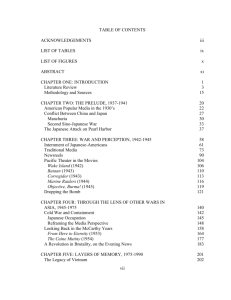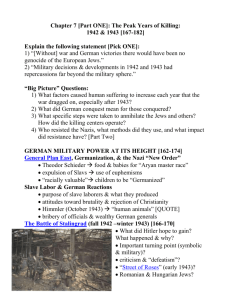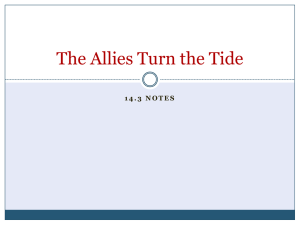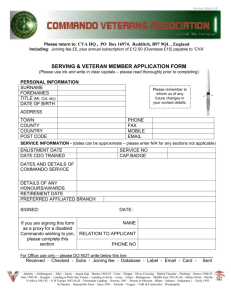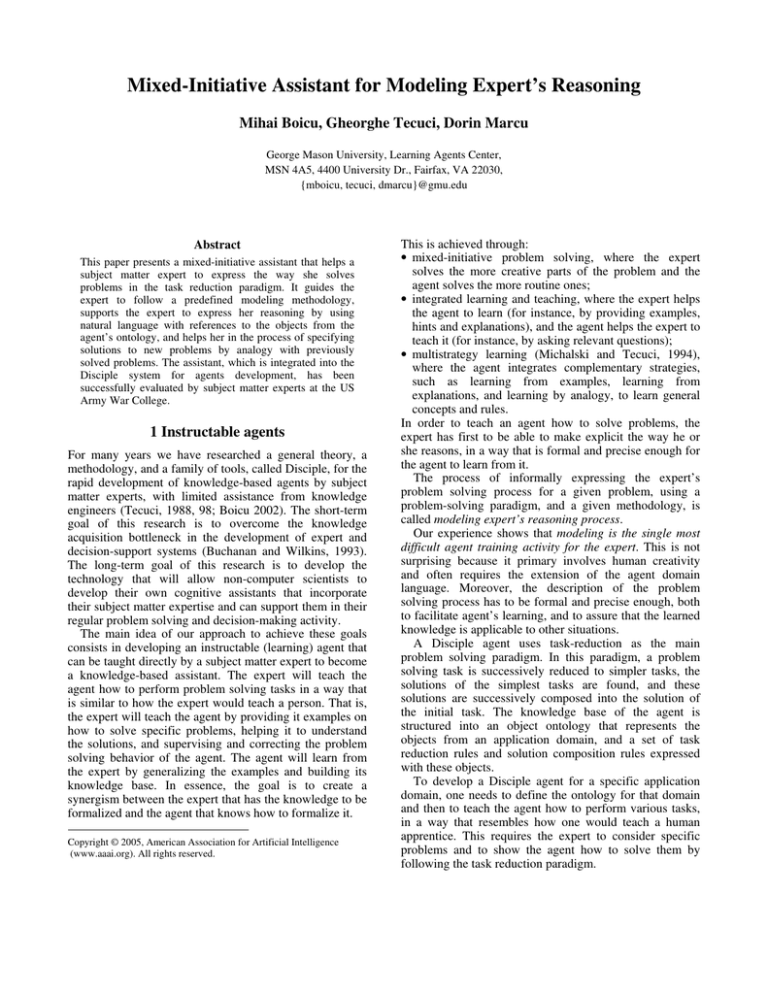
Mixed-Initiative Assistant for Modeling Expert’s Reasoning
Mihai Boicu, Gheorghe Tecuci, Dorin Marcu
George Mason University, Learning Agents Center,
MSN 4A5, 4400 University Dr., Fairfax, VA 22030,
{mboicu, tecuci, dmarcu}@gmu.edu
Abstract
This paper presents a mixed-initiative assistant that helps a
subject matter expert to express the way she solves
problems in the task reduction paradigm. It guides the
expert to follow a predefined modeling methodology,
supports the expert to express her reasoning by using
natural language with references to the objects from the
agent’s ontology, and helps her in the process of specifying
solutions to new problems by analogy with previously
solved problems. The assistant, which is integrated into the
Disciple system for agents development, has been
successfully evaluated by subject matter experts at the US
Army War College.
1 Instructable agents
For many years we have researched a general theory, a
methodology, and a family of tools, called Disciple, for the
rapid development of knowledge-based agents by subject
matter experts, with limited assistance from knowledge
engineers (Tecuci, 1988, 98; Boicu 2002). The short-term
goal of this research is to overcome the knowledge
acquisition bottleneck in the development of expert and
decision-support systems (Buchanan and Wilkins, 1993).
The long-term goal of this research is to develop the
technology that will allow non-computer scientists to
develop their own cognitive assistants that incorporate
their subject matter expertise and can support them in their
regular problem solving and decision-making activity.
The main idea of our approach to achieve these goals
consists in developing an instructable (learning) agent that
can be taught directly by a subject matter expert to become
a knowledge-based assistant. The expert will teach the
agent how to perform problem solving tasks in a way that
is similar to how the expert would teach a person. That is,
the expert will teach the agent by providing it examples on
how to solve specific problems, helping it to understand
the solutions, and supervising and correcting the problem
solving behavior of the agent. The agent will learn from
the expert by generalizing the examples and building its
knowledge base. In essence, the goal is to create a
synergism between the expert that has the knowledge to be
formalized and the agent that knows how to formalize it.
Copyright © 2005, American Association for Artificial Intelligence
(www.aaai.org). All rights reserved.
This is achieved through:
• mixed-initiative problem solving, where the expert
solves the more creative parts of the problem and the
agent solves the more routine ones;
• integrated learning and teaching, where the expert helps
the agent to learn (for instance, by providing examples,
hints and explanations), and the agent helps the expert to
teach it (for instance, by asking relevant questions);
• multistrategy learning (Michalski and Tecuci, 1994),
where the agent integrates complementary strategies,
such as learning from examples, learning from
explanations, and learning by analogy, to learn general
concepts and rules.
In order to teach an agent how to solve problems, the
expert has first to be able to make explicit the way he or
she reasons, in a way that is formal and precise enough for
the agent to learn from it.
The process of informally expressing the expert’s
problem solving process for a given problem, using a
problem-solving paradigm, and a given methodology, is
called modeling expert’s reasoning process.
Our experience shows that modeling is the single most
difficult agent training activity for the expert. This is not
surprising because it primary involves human creativity
and often requires the extension of the agent domain
language. Moreover, the description of the problem
solving process has to be formal and precise enough, both
to facilitate agent’s learning, and to assure that the learned
knowledge is applicable to other situations.
A Disciple agent uses task-reduction as the main
problem solving paradigm. In this paradigm, a problem
solving task is successively reduced to simpler tasks, the
solutions of the simplest tasks are found, and these
solutions are successively composed into the solution of
the initial task. The knowledge base of the agent is
structured into an object ontology that represents the
objects from an application domain, and a set of task
reduction rules and solution composition rules expressed
with these objects.
To develop a Disciple agent for a specific application
domain, one needs to define the ontology for that domain
and then to teach the agent how to perform various tasks,
in a way that resembles how one would teach a human
apprentice. This requires the expert to consider specific
problems and to show the agent how to solve them by
following the task reduction paradigm.
As mentioned above, this modeling process is very
complex and the question is how to develop an assistant
that can help the expert to perform it. One idea is to define
a simple modeling methodology and associated guidelines
which the expert can easily follow to express her reasoning
in the task reduction paradigm (Bowman, 2002). At the
same time develop mixed-initiative methods to help the
expert follow the methodology. Another idea is to allow
the expert to express her reasoning in a language that
combines natural language with references to the objects
from the agent’s ontology. This, in turn, requires the
modeling assistant to help the expert in identifying the
objects from the knowledge base she wants to refer to. Yet
another idea is to help the expert in the process of
specifying the solutions to new problems, by analogy with
previously defined solutions. All these ideas are at the
basis of the mixed-initiative modeling assistant integrated
into the Disciple system, as described in the rest of this
paper.
2 Modeling expert’s reasoning process
We have developed a simple and intuitive modeling
language in which the expert, with the help of the
modeling assistant, expresses the way she is solving a
specific problem, using natural language, as if the expert
would think aloud, as illustrated in Figure 1 (Bowman,
2002).
We need to “Assess whether President-Roosevelt has
means to be protected.” In order to perform this
assessment task, the expert and the agent will ask
themselves a series of questions. The answer to each
question will lead to the reduction of the current
assessment task to simpler assessment tasks. The first
question asked is: “What is a means of President Roosevelt
to be protected from close physical threats?” The answer,
“US Secret Service 1943,” leads to the reduction of the
above task to the task “Test whether US Secret Service
1943 has any significant vulnerability.”
In general, the question associated with a task considers
some relevant piece of information for solving that task.
The answer identifies that piece of information and leads
to the reduction of the task to one or several simpler tasks.
Alternative questions correspond to
alternative approaches to solving the
current problem solving task. Several
answers to a question correspond to several
potential solutions. The modeling language
includes many helpful guidelines for the
expert, such as: Ask small, incremental
questions that are likely to have a single
category of answer (but not necessarily a
single answer). This usually means ask
who, or what, or where, or what kind of, or
is this or that etc., not complex questions
such as who and what, or what and where.
The expert expresses her reasoning in
natural language, but the modeling
assistant provides her with helpful and
non-disruptive mechanisms for automatic identification of
the knowledge base elements in her phrases. In particular,
the modeling assistant has an effective word completion
capability. When the expert types a few characters of a
phrase, such as, “means to be protected” (see Figure 1), it
proposes all the partially matching names from the
knowledge base, ordered by their plausibility, to be used in
the current context, including “means_to_be_protected.”
The expert selects this name only because it is simpler than
typing it. However, now the system also partially
“understands” the English sentence entered by the expert,
which will significantly facilitate their collaboration.
We need to
Test whether President_Roosevelt has means_to_be_protected.
Question:
What is a means of President_Roosevelt to
be_protected from close physical threats?
Answer:
US_Secret_Service_1943
Therefore we need to
Test whether US_Secret_Service_1943 has any significant vulnerability.
Question:
Which is a significant vulnerability of the US_Secret_Service_1943?
Answer:
US_Secret_Service_19433 has no significant vulnerability because
its loyalty_of_the_US_Secret_Service_1943 is based on conviction
and it cannot be influenced by European_Axis_1943.
Therefore we conclude that
The US_Secret_Service_1943 which has no significant vulnerability is a
means_to_be_protected for President_Roosevelt.
Figure 1: A sequence of two task reductions steps
3 Modeling Assistant interface
Figure 2 shows the interface of the modeling assistant. The
middle part of the screen contains the current task
reduction step that the expert is composing. At each state
in this process, the right hand side of the screen shows all
the actions that could be performed in that state, and the
left hand side shows the action that the modeling assistant
is actually recommending. For instance, to specify the
current subtask, the advisor suggested the expert to copy
Figure 2: Modeling Adviser interface
and to modify the if-task. The modeling assistant may also
suggest the question to be asked, or the answer of the
question. As mentioned, the expert expresses her reasoning
in English. However, each time she starts to type a word,
the agent lists in the left hand side of the screen all the
instances and concepts from the knowledge base that are
consistent with the characters typed so far (see Figure 2).
4 Checking expert’s modeling
The modeling assistant, through its Example Analyzer
module, also checks whether a task reduction step
specified by the expert is correct and suggests
improvements to make it complete and consistent with the
modeling that was already done. Figure 3 illustrates some
of the improvements that might be suggested by the
Example Analyzer.
There are two types of analysis done by the Example
Analyzer. There is a global analysis that attempts to
discover problems with the entire example or with its place
in the overall model. There is also a local analysis that
deals with the components of the example.
Strategy
proliferation
Task 1
modeling(i1,i2,i3)
Question 1(i2)
Answer 1(i2,i4)
Task 2
modeling(i1,i5)
In other situations you have asked: Question
1'(i1) Why isn’t applicable in this case?
• It is applicable, and it does not matter
which one I ask first.
• It is applicable, but it is more important
to ask Question1.
• It is not applicable.
Variables flow
Your answer does not reflect the relation
between i2 (or i4) and i5.
Task
reformulation
Does this task mean the exact
same thing as one of the following tasks?
Task 2'
modeling(i1,i5)
Task 2''
modeling(i1,i5)
Figure 3: Example Analyzer strategies
One strategy for global analysis is to look at the variable
flow. Our modeling methodology recommends that the
subtasks should only refer to the variables from the if-task,
question and answer. During learning all the new variables
introduced by the question, the answer and the subtasks
must be somehow linked to the input variables from the iftask. Therefore, another method is to check that there is a
path between each new variable and one of the input
variables. If this rule is not followed it is much more
difficult to correctly generalize the example.
Another important aspect of the modeling methodology
is the minimization of the number of strategies for solving
a task (a strategy being represented by the question from
the task reduction step). If the expert uses more than one
strategy then it is important to make sure that this is a
reasonable thing to do (by requesting a confirmation). If
the expert changes her mind some correction is proposed.
For instance, if the expert selects the first justification from
Figure 3, (i.e. "It is applicable, and does not matter which
one I ask"), the agent will replace Question1 (i2) with
Question 1'(i1).
5 Assisting the expert to compose an example
The most challenging part is how to help the expert when
he models a new problem solving step, as the ones
presented in the Figure 1. Even though the system is not by
itself creative it might still help the expert in this process,
enhancing the expert's capabilities.
The modeling methodology follows a top-down
definition of the examples. Therefore, the if-task of an
example will be either the initial problem to be solved or it
has already been defined from the previous problem
solving episode. It is difficult for the agent to guess the
right continuation, but it may suggest several plausible
continuations, letting the expert to select and edit the most
appropriate one.
There are three main goals in developing such methods:
1) to facilitate the continuation of a partial problem
solving example;
2) to help the expert define the current example in a
form which is consistent with previously entered
knowledge;
3) to guide the expert follow the modeling methodology.
The heuristic methods developed fall under three
categories that will be discussed in the next sections:
1) methods that suggest continuations of the current
example based on different levels of similarity between the
current example and previously learned rules and/or
previously defined (but not yet formalized) examples;
2) methods that suggest questions and answers based on
plausible explanations and interpretations of the example;
3) methods based on the modeling methodology and on
knowledge engineering guidelines.
5.1 Suggesting questions to continue an example
In this section we consider the case when the user is
expressing the question, as part of a problem solving step.
We present heuristic methods that can be used to suggest
this question. The questions and their answers have been
introduced into the task-reduction paradigm in order to
capture the rationality of performing the corresponding
reductions. The question by itself may be considered an
abstraction of the strategy used to reduce the current task.
Also, the question together with its answer offers an
informal justification of why a particular reduction is
made.
In the general modeling methodology for task reduction
we have the following guideline related to the question:
“For a task attempt to use the same question in all
problem solving episodes.” But there are situations when
the modeling requires asking a different question for the
same task. However, we need to be very conservative with
the proliferations of the questions for the same task.
Therefore, the top level heuristic in suggesting a question
is based on this methodological guideline.
This heuristic method distinguishes between two cases.
In the first case the example was just started (i.e. it does
not yet contain a question) and the if-task was already used
in other examples. Because the if-task was already used in
other examples there is at least one question associated
with it. Therefore, based on the above modeling guideline,
the method will propose questions which are similar with
the existing ones. In the second case either the task is used
for the first time (i.e. no other rules or examples use it,
which means that there is no question associated with the
if-task), or the user started a new question. If the user
started a new question, this suggests that none of the
proposed ones was useful. In this second case the method
will propose questions based on similar rules and
examples. We will discuss each of these cases separately.
First we will discuss how to propose questions similar
with the ones already associated with this if-task. Such a
question may appear in a rule having the same if-task or in
an example having the same if-task (example that was not
yet generalized into a rule). Because usually a question
contains values that refer to a particular problem solving
step the method must construct a similar question, with the
same pattern but with the values determined by analogy
with current task instantiation. Table 1 summarizes this
method.
In order to compare the plausibility of the generated
questions we consider the confidence in our analogical
reasoning. We assume that the confidence is a number
between 0 and 1 where 1 represents the highest confidence
and is computed based on the following heuristics:
Case 1: For the questions similar with the questions
from the rules with the same if-task (in method SQT-R),
we will use a measure of their instantiation: an analogous
example that is better instantiated with the task values has
more chances to be similar with the currently edited
example. The confidence function used is: f1(E, R,
T(i1,i2,…))= (percent of instantiated variables in
question(E))/2 + (percent of instantiated variables in
example(E))/2.
Case 2: For the questions similar with the questions
from the unformalized examples with the same if task (in
method SQT-E), we will use a measure of their
instantiation: f2(IE, ET, T(i1,i2,…))=(percent of instantiated
variables in question(IE))/2 + (percent of instantiated
variables in example(IE))/2.
Case 3: The main method SQT, combines these
measures of confidence. We are less confident in the
questions from the examples which are not yet formalized
in a rule, because such a question may be further changed
before or during the rule learning process.
The second approach is to propose questions based on
rules and examples having if-tasks which are similar with
the current one. For each similar task this method will
generate the questions by using the method from Table 2.
5.2 Explanation-based heuristics
This class of heuristics uses plausible explanations of the
current partial problem solving step in order to improve the
Table 1: Method to suggest questions used with a task (SQT)
Suggest-questions-from rules: SQT-R(T(i1,..., ik), n)
Find the n most plausible questions (Qj)j n for the task T(i1,..., ik)
similar with the questions from the rules with the same if-task T
SQ←∅
for each rule R to solve task T do
for each instantiated example E generated by R(i1,..., ik) do
Q←the partially instantiated question from example E
confidence(Q)←f1(E,R,T(i1, i2,..., ik))
if Q∉SQ then add Q in SQ
else increase confidence for Q in SQ
return first n elem from SQ in the decreasing confidence
order
Suggest-questions-from examples: SQT-E(T(i1, i2,..., ik), n)
Find the n most plausible questions (Qj)j n for the task T(i1..., ik)
similar with the questions from the examples for if-task T
SQ←∅
for each example E (not generated by a rule) to solve task T
do
ET← template of E (values replaced with variables)
IE←the instantiation of the template ET with i1, i2,..., ik
Q←the partially instantiated question from example IE
confidence(Q)←f2(IE, ET, T(i1, i2,..., ik))
if Q∉SQ then add Q in result SQ
else increase confidence for Q in SQ
return first n elem from SQ in the decreasing confidence
order
Suggest-questions-used-for-a-task: SQT(T(i1, i2,..., ik), n)
Find the n most plausible questions (Qj)j n for the task T(i1, i2,...,
ik) using the questions already used for it
SQ1←SQT-R(T(i1, i2,..., ik),n)
for Q∈SQ1 do confidence(Q) ← 1/2 + confidence(Q)/2
SQ2←SQT-E(T(i1, i2,..., ik),n-|SQ|)
for Q∈SQ2 do confidence(Q) ← confidence(Q)/2.01
return SQ1+SQ2
Table 2: Heuristic method to suggest questions from examples
with similar if tasks (SQA)
Suggest-questions-from-similar-examples: SQA(E(i1,...ik), n)
Find the n most plausible questions (Qj)j n for the example
E(i1,..., ik) similar with questions from the rules and examples
having an similar if-task
SQ←∅; Temp-SQ←∅
T(πT(i1, i2,..., ik))←the if task from the example E(i1, i2,..., ik)
for each task AT(σ(i1, i2,..., ik)) which is σ-similar with
T(πT(i1, i2,..., ik)), generated in decreasing order of their
similarity-conf(AT,T) do
move to the end of SQ the questions from Temp-SQ with
the confidence ≥f3(max-question-conf, similarityconf(AT,T))
if |SQ|≥n then return first n elements from SQ
New-SQ←SQT(AT(σ(i1, i2,..., ik)),n-|SQ|)
for each Q∈New-SQ do
conf(Q)←conf(Q)/2+similarity-conf(AT,T)/2
merge New-SQ into Temp-SQ
add Temp-SQ to the end of SQ
return first n elements of SQ
Previously Learned Rule R-0023
suggestions already made through the Previous Example
Test the will_of_the_people_of_US_1943 which is a strategic
Test the Variable-1 which is a strategic COG candidate with
previously presented methods or to COG candidate with respect to the people_of_US_1943
respect to the Variable-2
What is the main strategic_goal of European_Axis_1943?
What is the main strategic_goal of Variable-3?
make new ones. There are three cases
Dominance_of_Europe_by_European_Axis
when such heuristics are used. The first
Variable-4
whether the will_of_the_people_of_US_1943 can make
Test whether the Variable-1 can make Variable-5 accept
case is when the questions, answers or Test
US_1943 accept Dominance_of_Europe_by_European_Axis
Variable-4
tasks are generated by analogy with a
European_Axis_1943 is_opposed_to Allied_Forces_1943,
Variable-3 is_opposed_to Variable-6,
Allied_Forces_1943 has_as_member US_1943
Variable-6 has_as_member Variable-5
rule and have missing values. The
US_1943 has_as_people people_of_US_1943
Variable-5 has_as_people Variable-2
second case is when the analogy is made
...
...
with an unformalized example.
Current Partial Example
1. Question suggested based on R-0023
Let us consider the situation from
Test the industrial_capacity_of_Germany_1943 which is a
What is the main strategic_goal of Variable-3?
Figure 4. It illustrates the method for the
strategic COG candidate with respect to the
economy_of_Germany_1943
Variable1= industrial_capacity_of_US_1943
case when it completes the definition of
Generate
Variable2= economy_of_US_1943
(state) has_as_component
a question. In the upper-left part side of
2. plausible
Variable-3 is_opposed_to Variable-6,
analogical
Variable-6 has_as_member Variable-5
the figure there is a previously entered
has_as_economy
has_as_people
explanations
Variable-5 has_as_people Variable-2
example. From this example the agent
Allied_Forces_1943 is_opposed_to European_Axis_1943,
...
European_Axis_1943 has_as_member Germany_1943
has learned a general task reduction
Germany_1943 has_as_economy economy_of_Germany_1943
rule, a fragment of which is presented in
3. Final suggested question based
...
on explanation heuristics
the upper-right part of the figure. The
bottom part of the figure shows the steps
What is the main strategic_goal of Allied_Forces_1943?
of the method. The current partial
Figure 4: Completion of an element generated by analogy with a rule
example contains only the if-task: “Test
the industrial_capacity_of_Germany_
no direct correspondent of variable-3 that appears in rule.
1943 which is a strategic COG candidate with respect to
To find the value of variable-3 the proposed method use
the economy_of_Germany_1943”. This task has the same
the rule’s explanations. These explanations represent an
pattern with the if-task of the rule from the top of the
ontology pattern that links the matched variables (variablefigure. Therefore, the previously presented SQT method
1 and variable-2) and the unmatched variable (variable-3),
will generate an incomplete analogous question “What is
through features and other variables, as presented in the
the main strategic_goal of variable-3?” However, there is
bottom-right part of Figure 4. Now, the method searches
the object ontology for analogical structures constructed
with
the
known
values
from
example
Table 3: Heuristic method for explanation-based completion
(industrial_capacity_of_Germany_1943 and economy of
Germany_1943). The most complete such analogous
Explanation based completion
explanation structure is presented in the bottom-left part of
EBC(E, Q, R, BoundedVars((v1,i1),(v2,i2)...(vk,ik)),
the figure. It replaces the feature has_as_people with the
UnboundedVars(vk+1, vk+2,...vp))
similar feature has_as_economy, constructing a plausible
Complete the question Q generated from rule R with the most
explanation for the proposed question. This explanation
plausible instantiations of variables based on the current
example E.
determines
the
value
for
variable-3
as
Allied_Forces_1943. Usually, there is more than one
V(Q)← variables from question Q which are not
instantiated
plausible explanation. In such cases the method must
if V(Q)=∅ then return Q(i1, i2,...ik)
analyze them and use only the most plausible ones. To
for each variable v∈V(Q) do
estimate their plausibility the method uses the confidence
in the similarity between the proposed explanation and the
Path(v)←acyclic paths in rule explanations from v
to bounded variables
explanation of the rule from the top-left part of the figure.
V(Q)←{v∈V(Q)|v has the minimum distance to one of
Because the plausible explanation shown in Figure 4 has
bounded variables}
the best confidence it will be first selected. Finally the
V(Q)←{v∈V(Q)|v has links with the maximum number
completed question will be proposed to the user.
of bounded vars.}
This method is presented in Table 3. This is a recursive
v←first element in V(Q)
method that returns only the best question, but it may
AE(v)←the best analogous fully instantiated
easily be adapted to return the best n questions.
explanations with Path(v)
The second case is when the analogy to generate the
SQ←∅; confidence(SQ)←0;
initial question was made with an unformalized example
for each expl∈AE(v) do
E1 and not with a rule. The difference is that we do not
BV←newly bounded variables in expl
have the explanations based on which to construct the
Q←EBC(E, Q, R, boundedvars∪BV,
analogy. Therefore, in the first phase we will construct the
unboundedVars\BV)
plausible justification of E1. Then the method will
confidence(Q)←(confidence(Q)+confidence(expl))
continue in a similar way. However, we will determine
/2
plausible explanations for E analogous only with some of
if confidence(Q) > confidence(SQ) then SQ←Q
the constructed explanations for E1.
return SQ
6 Experimental results
We have performed two knowledge acquisition
experiments at the US Army War College. In the first
experiment we have used a modeling editor that allowed
the expert to define and modify a reasoning tree, as
illustrated in Figure 1, but offered no help. In the second
experiment the experts used the presented modeling
assistant that provided help during the modeling process.
One important observation is that in the second
experiment, using the modeling assistant, the experts
succeeded to model more reasoning steps (31 on average,
as compared to 19 in the other experiment) containing
creative solutions, with relatively reduced knowledge
engineering help.
At the end of each experiment the experts completed a
detailed questionnaire. The most relevant results obtained
for the modeling assistant are presented in Figure 5 and
Figure 6.
being very good. Although the suggestions are based on
plausible reasoning, and are expected to not always be
good, they clearly helped the creative process of modeling.
In conclusion, the use of the modeling assistant allowed
the experts to better express their expertise, facilitating
their interaction with the Disciple agent and reducing the
need for help from a knowledge engineer.
How would you characterize the suggestions given by this
module
always useful
generally useful
sometimes useful
MEDIAN
generally useless
always useless
0
5
10
15
How would you characterize
the understandability of the suggestions given by this module
always understandable
generally understandable
Choose the statement that best characterizes your experience
with learning to use this module
sometimes understandable
I needed help only the first time
of using a new option of this module
MEDIAN
generally not understandable
I learned to use this module
in a reasonable amount of time
always not understandable
I learned easily to use
the basic capabilities of the module
0
MEDIAN
I still do not know how to use
the basic capabilities of this module
5
10
15
Choose the statement that best characterizes your experience
with using this module, after you have learned to use it
very easy to use
MEDIAN
sometimes easy,
sometimes difficult to use
very difficult to use
5
10
15
Choose the statement that best characterizes
the general design of the graphical interface of this module
MEDIAN
generally well organized
neutral
generally poorly organized
not intuitive and poorly organized
0
Acknowledgements. This research was sponsored by
several US Government agencies, including DARPA,
AFRL, AFOSR, and US Army War College.
Boicu, M. 2002. Modeling and Learning with Incomplete
Knowledge, Ph.D. Dissertation, Department of Computer
Science, George Mason University.
generally difficult to use
intuitive and well organized
15
References
reasonably easy to use
0
10
Figure 6: Evaluation of modeling assistant’s suggestions
I learned with difficulty to use
the basic capabilities of the module
0
5
5
10
15
Figure 5: General evaluation of the modeling assistant
These results represent clear improvements on all the
aspects taken into account, as compared to the Modeling
Editor. For example, all but one expert considered that it
was easy to learn to use the modeling assistant. Also this
module was considered reasonably easy to use and its
graphical user interface was generally considered well
organized.
Figure 6 shows the evaluation of the suggestions given
to the experts by the modeling assistant. Notice that the
experts considered these suggestions as being generally
useful and understandable. We consider these results as
Bowman, M. 2002. A Methodology for Modeling Expert
Knowledge that Supports Teaching Based Development of
Agents. Ph.D. Dissertation, Department of Computer
Science, George Mason University.
Buchanan, B.G. and Wilkins, D.C. eds. 1993. Readings in
Knowledge Acquisition and Learning: Automating the
Construction and Improvement of Expert Systems. San
Francisco, CA: Morgan Kaufmann.
Michalski, R. S. and Tecuci, G., eds. 1994. Machine
Learning: A Multistrategy Approach Volume 4. San
Mateo, CA.: Morgan Kaufmann.
Tecuci G. 1988. DISCIPLE: A Theory, Methodology and
System for Learning Expert Knowledge, Thèse de Docteur
en Science, University of Paris-South.
Tecuci, G. 1998. Building Intelligent Agents: An
Apprenticeship
Multistrategy
Learning
Theory,
Methodology, Tool and Case Studies. London: Academic
Press.

